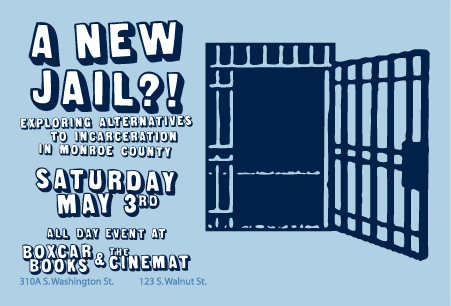In ecological terms, an indicator species is life that can draw attention to the condition of an ecosystem and even warn of an impending biological crisis. The Pittsburgh-based performance group, The Indicator Species, tries to draw attention to social crisis – the unbounded growth and abuse of the prison industrial complex and violence in our communities – in their shadow puppet performance, The Hardest Question Ever, which will be performed Thursday, July 6 at the Monroe County Public Library Auditorium at 6pm. Admission to this performance is free.
In their 30-minute multimedia performance that beautifully combines live music, life-sized shadow puppets, projection, letters from prison inmates, and recorded audio, The Indicator Species tells three true stories of violence and incarceration from their community in Pittsburgh. However, these stories are ones that can and have repeated themselves and provoked communities to ask hard questions in Pittsburgh, Bloomington, and places all over the country.
In one story, a man with a history of violence and closely connected to the Pittsburgh activist community is convicted of rape and murder. In another story, a teenager murders his best friend in a manic episode. In the last story, a well-loved member of the community who was deeply involved in community building and organizing, is murdered while walking home by a group of youth from his neighborhood.
All of these stories remind us of the complicated nature of violence and punishment in our society and how our fears about these things creep and twist around questions of race, class, prejudice, security, justice, and compassion. In the end we are left with no easy answers, but only more questions. Does the prison system protect us from members of our communities who we consider to be dangerous? Or does it contribute to social conditions that aggravate violence? Can the prison system, or any system, rehabilitate those who have committed horrible acts against others? How do we feel safe with our neighbors and in our communities? Following the performance, there will be a discussion about violence, community, and prisons where the performers, audience members, and representatives from Bloomington community groups involved in addressing issues of violence, punishment, and rehabilitation can discuss some of the questions raised by the performance.
Though there is no explicit language or imagery in the performance, it does directly address the reality of rape, murder, domestic violence, and incarceration and may not be suitable for young children.
The Indicator Species is a group of activists, educators, artists, and performers who engage in prison and other community issues through a variety of groups and projects in Pittsburgh. These projects includethe Book Em’ books to prisoners project and The Prison Poster Project, a collaborative art project that combines prisoner art to create an educational tool about the prison industrial complex. Their performance evokes the politically charged imagery of artists such as Seth Tobocman and the powerful delicacy of shadow puppeteers such as Eric Ruin. In addition to their Bloomington performance, The Indicator Species is touring throughout the summer with The Hardest Question Ever, bringing their provocative performance and dialogue to a number of different communties across the country.
The Bloomington performance of The Hardest Question Ever is produced in conjunction with The Midwest Pages to Prisoners Project and as part of this summer’s Plan-It-X Fest. The Midwest Pages to Prisoners Project is a long-running volunteer effort that meets weekly to send free books and other reading material to people in prison for the purpose of self-education, rehabilitation, and relieving pain and boredom. It also hopes to offer an accessible way for members of the community to begin to think and talk about prison issues. In its third year, Plan-It-X Fest is a week long festival of musical performance, workshops, and classes exhibiting and fostering do-it-yourself music, art, activism, and community.
For more information
